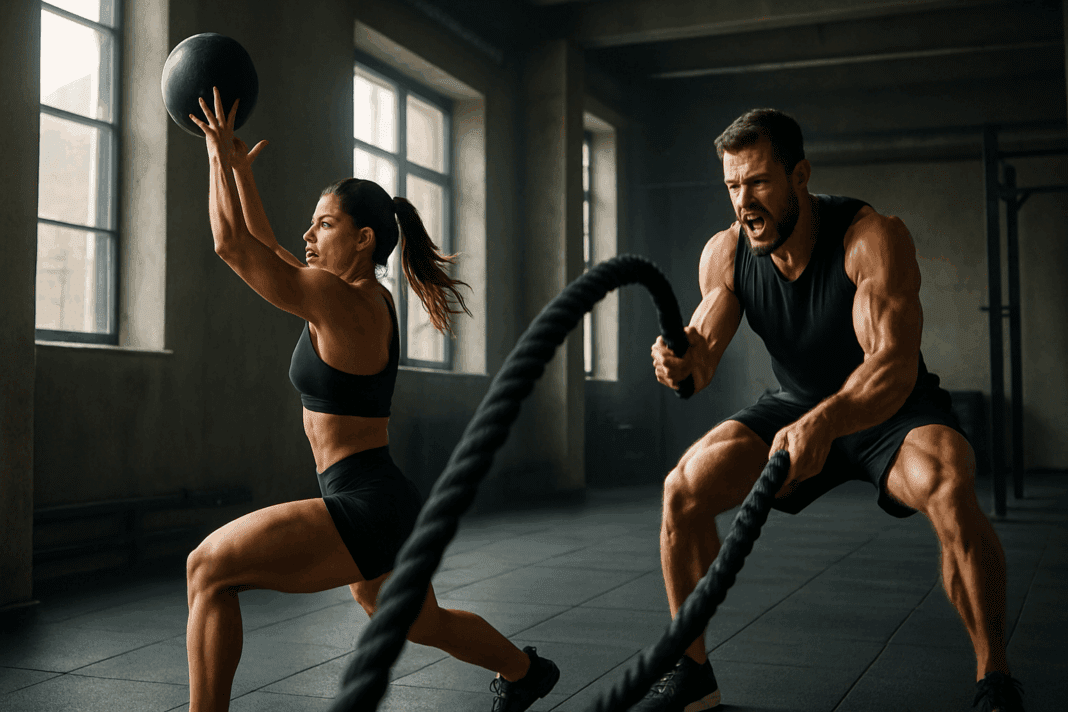In today’s fast-paced world, fitness enthusiasts and athletes alike seek training methods that offer maximum results in minimal time. Among the most effective strategies emerging in recent years is high intensity interval training, commonly known as HIIT. While HIIT is often associated with lower-body or cardio-centric routines, an increasingly popular and highly effective adaptation involves focusing on upper body training. High intensity upper body exercises do more than sculpt shoulders and chests—they offer a powerful boost to overall strength, stamina, and functional performance. This article explores how upper body HIIT enhances both muscular endurance and cardiovascular efficiency, making it an essential addition to any serious fitness regimen.
You may also like: How to Increase Stamina and Endurance Naturally: Smart Training Tips and Nutrition Habits That Support Cardiovascular Fitness

Understanding High Intensity Interval Training and Its Upper Body Focus
High intensity interval training is defined by alternating periods of short, intense anaerobic exercise with less intense recovery periods. This format not only accelerates fat loss but also improves cardiovascular health and metabolic efficiency. Traditionally, HIIT has been applied to exercises like sprinting, cycling, and lower-body plyometrics. However, adapting HIIT to target the upper body brings a unique set of benefits, from improved muscular hypertrophy to enhanced oxygen uptake.
The inclusion of high intensity interval training for the upper body allows individuals to work the muscles of the chest, shoulders, arms, and upper back with minimal rest in between sets. Exercises such as push-ups, dumbbell thrusters, battle ropes, and explosive medicine ball slams can be structured into intervals that tax the muscles while keeping the heart rate elevated. The result is a dual stimulus that promotes both anaerobic power and aerobic capacity—a rare combination in traditional strength training methods.
Why High Intensity Upper Body Exercises Matter for Performance
Performance training requires a comprehensive approach, targeting not just strength but also speed, power, and endurance. High intensity upper body exercises fulfill this multidimensional goal. Unlike isolated resistance movements that may focus on a single muscle group in a slow, controlled manner, upper body HIIT involves dynamic, compound movements that engage multiple muscle groups and energy systems simultaneously.
Consider an exercise like the plyometric push-up, where the explosive power required activates fast-twitch muscle fibers, essential for activities demanding quick bursts of energy. When integrated into an interval training structure, such movements also contribute to greater muscular endurance. This hybrid demand enhances neuromuscular efficiency, teaching the body to recruit muscle fibers more effectively under stress—a trait vital for athletes and professionals who perform in physically demanding environments.
Moreover, incorporating upper body HIIT can lead to functional strength gains. Functional strength refers to the kind of strength that translates to real-world activities, whether it’s lifting, throwing, pulling, or climbing. These movement patterns often engage the upper body in conjunction with the core, which HIIT routines naturally incorporate due to their dynamic nature. Thus, the benefits extend beyond the aesthetic to real-life applicability.
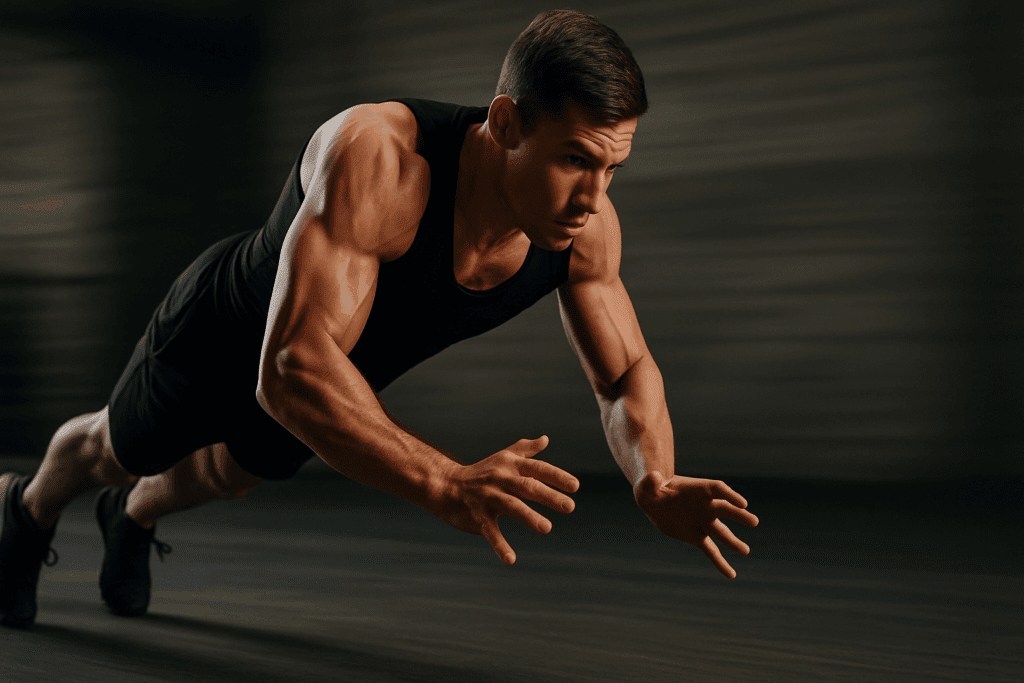
Endurance and Metabolic Conditioning Through Upper Body HIIT
One of the standout benefits of high intensity interval training upper body routines is their impact on endurance. Typically, endurance training is associated with long-distance running or cycling. However, recent studies indicate that HIIT can significantly improve endurance even when primarily targeting upper body musculature. This is due to the cardiovascular demands placed on the body when large upper body muscle groups are repeatedly activated in rapid succession.
The body responds to this type of training by increasing capillary density, mitochondrial biogenesis, and lactate threshold in the trained muscles. In simpler terms, this means the muscles become more efficient at using oxygen and disposing of metabolic byproducts, which translates to improved performance over time. For instance, athletes who perform high intensity upper body exercises consistently report enhanced upper body stamina, allowing them to maintain high output during sports like boxing, swimming, rowing, and rock climbing.
Metabolic conditioning is another key benefit of upper body HIIT. Because this style of training elevates the heart rate quickly and keeps it elevated throughout the session, it increases the body’s resting metabolic rate (RMR). An elevated RMR leads to more calories burned even during rest, making upper body HIIT an effective tool for fat loss and body composition improvement.
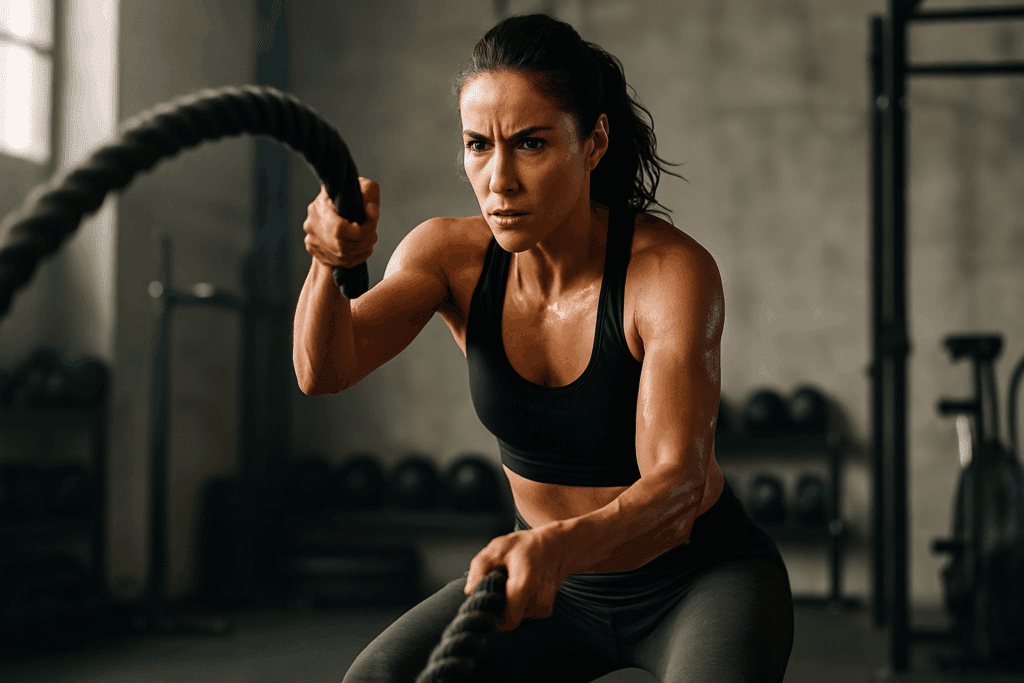
The Role of HIIT in Enhancing Muscular Strength and Power
While endurance is a crucial aspect of athletic performance, strength and power are equally important. High intensity upper body exercises are particularly effective for developing explosive strength, especially when movements are executed with maximal effort during short bursts. This kind of training not only builds muscle but also enhances the rate of force development (RFD), which is critical for performance in sports that require quick, powerful movements.
Take the battle rope slam, for example. This movement involves rapid, repetitive contractions of the upper body muscles, particularly the shoulders, arms, and upper back. When performed in timed intervals, it demands both muscular endurance and power output. Similarly, medicine ball throws and kettlebell clean-and-press exercises involve explosive movements that train the muscles to generate force quickly and effectively.
Moreover, these exercises often challenge stabilizing muscles and the core, leading to more balanced strength gains across the kinetic chain. Unlike isolated movements, these compound exercises create a more integrated form of strength, improving not just how much force a muscle can produce but also how efficiently that force is applied during real-world or sport-specific tasks.

Hormonal and Physiological Benefits of High Intensity Upper Body Exercises
Engaging in high intensity interval training upper body workouts triggers a cascade of beneficial hormonal responses. One of the most significant is the release of growth hormone (GH) and testosterone, both of which are instrumental in promoting muscle growth and recovery. These hormones are naturally elevated following intense exercise sessions, particularly those involving large muscle groups and explosive movements.
Furthermore, HIIT has been shown to increase insulin sensitivity, which is crucial for metabolic health and effective nutrient partitioning. This means that after a HIIT session, the body becomes more efficient at directing nutrients toward muscle repair and energy storage rather than fat accumulation. This effect is especially valuable for individuals seeking to improve body composition or manage blood sugar levels.
Physiologically, upper body HIIT enhances cardiac output and stroke volume, both of which are indicators of improved heart health. Unlike traditional weightlifting, which may cause temporary increases in blood pressure, HIIT encourages cardiovascular adaptations that result in more efficient blood flow and oxygen delivery throughout the body. Over time, this leads to improved endurance, reduced risk of chronic diseases, and enhanced physical resilience.
Designing an Effective Upper Body HIIT Program
Creating a high intensity upper body workout requires thoughtful programming to ensure both safety and effectiveness. It’s important to select exercises that engage multiple muscle groups and can be performed with high intensity and proper form. A typical upper body HIIT session might include exercises like push-up variations, overhead dumbbell presses, bent-over rows, mountain climbers, and bear crawls.
Each exercise should be performed for a set duration, typically 30 to 45 seconds, followed by a brief rest period of 15 to 30 seconds. This structure allows for maximum exertion during the work intervals while providing just enough recovery to maintain performance throughout the session. A complete workout might consist of three to five rounds of four to six exercises, totaling 20 to 30 minutes.
Progressive overload is a key principle in any training program. For upper body HIIT, this can be achieved by increasing the intensity (e.g., using heavier weights or faster reps), volume (e.g., adding more rounds), or complexity (e.g., incorporating unstable surfaces or explosive variations). It is also essential to balance the training week with adequate recovery days and include mobility work to prevent overuse injuries.
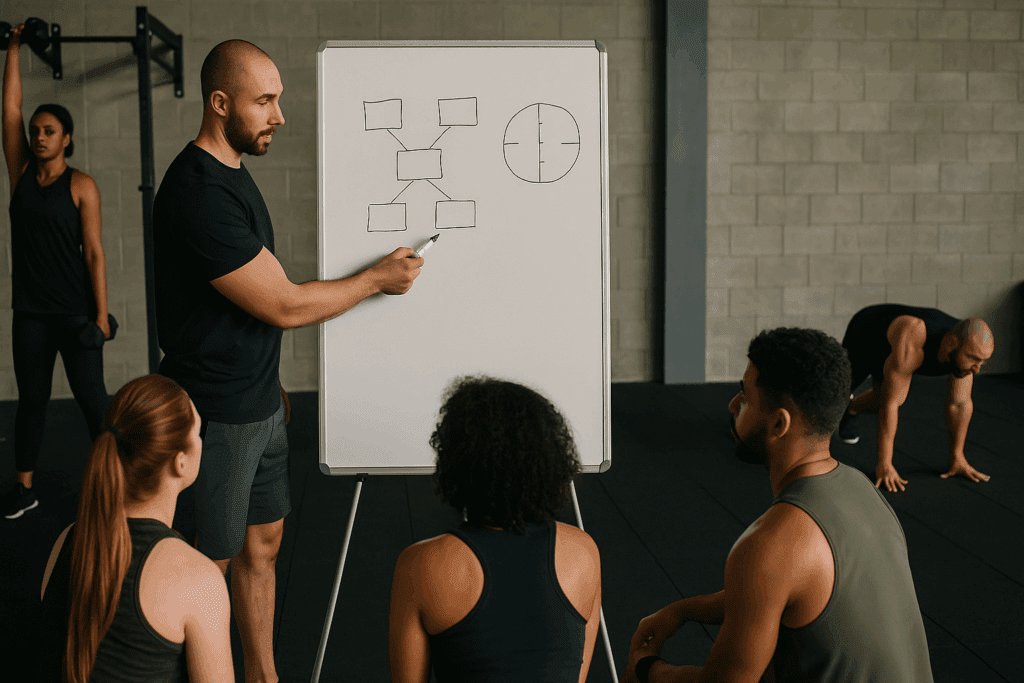
Common Mistakes and How to Avoid Them in Upper Body HIIT
Despite its effectiveness, upper body HIIT can pose risks if not executed properly. One of the most common mistakes is poor form, often resulting from fatigue or a lack of proper technique. When performing high intensity upper body exercises, maintaining correct alignment and posture is crucial to avoid strain on joints and ligaments. It is advisable to master movement patterns at a lower intensity before progressing to high-speed or weighted versions.
Another frequent error is neglecting recovery. Because HIIT is demanding on both the muscular and central nervous systems, insufficient rest can lead to overtraining and diminished results. Athletes and fitness enthusiasts should ensure they get enough sleep, stay hydrated, and consume a nutrient-rich diet to support recovery and performance gains.
A third mistake involves neglecting warm-up and cool-down routines. Preparing the body with dynamic movements before a session and winding down with static stretches afterward helps reduce injury risk and facilitates better overall results. A well-structured warm-up enhances neuromuscular activation, while post-workout stretching can improve flexibility and expedite recovery.
Integrating Upper Body HIIT into a Holistic Fitness Plan
High intensity upper body exercises should not exist in isolation but rather function as a component of a comprehensive training program. For optimal performance and endurance gains, individuals should integrate upper body HIIT with lower body strength work, cardiovascular conditioning, mobility training, and recovery strategies. This holistic approach ensures balanced development and prevents overreliance on a single modality.
For example, a weekly routine might involve upper body HIIT on Monday and Thursday, lower body strength training on Tuesday and Friday, and active recovery or mobility-focused sessions on Wednesday and Sunday. This variety not only keeps workouts engaging but also reduces the likelihood of muscular imbalances and overuse injuries.
Additionally, tracking progress through metrics such as heart rate variability, strength benchmarks, and endurance performance can help refine training intensity and volume. By monitoring these indicators, athletes can adjust their routines to match recovery needs and training goals, thereby maximizing the return on investment from every workout.
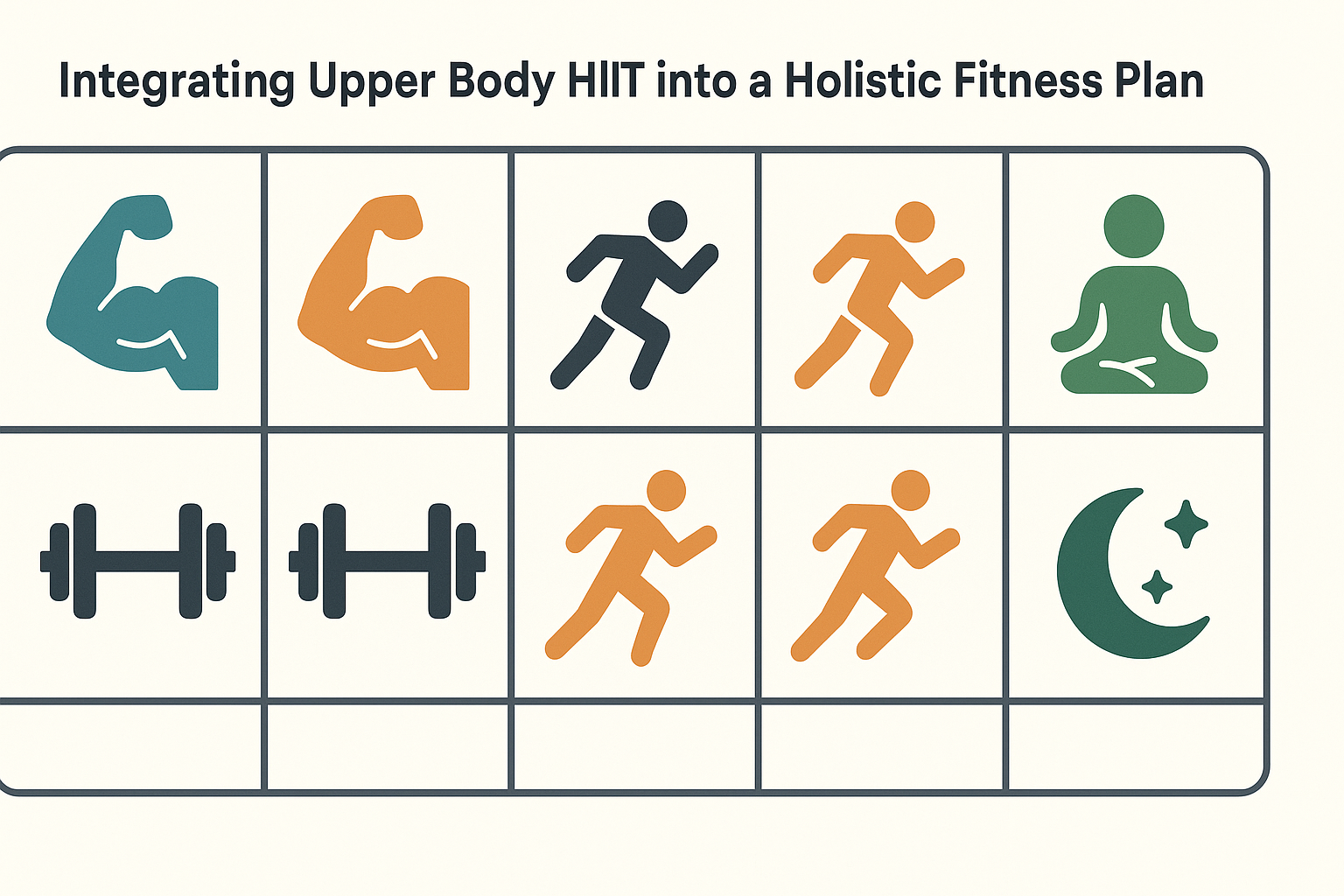
Who Benefits Most from High Intensity Upper Body Training?
While high intensity interval training upper body routines are suitable for a wide range of individuals, certain populations may derive particularly notable benefits. Athletes in sports that demand upper body endurance and power—such as swimmers, climbers, martial artists, and rowers—can use these routines to enhance their sport-specific performance.
Additionally, busy professionals looking to optimize their fitness in limited time frames often turn to upper body HIIT for its efficiency. In just 20 to 30 minutes, they can achieve a comprehensive workout that improves cardiovascular health, builds strength, and supports metabolic function. The time-saving nature of HIIT makes it accessible and sustainable even for those with packed schedules.
Older adults, when cleared by a healthcare provider, may also benefit from modified upper body HIIT routines. These can help maintain muscle mass, joint function, and cardiovascular health while promoting metabolic stability. Of course, proper scaling and supervision are critical to ensure safety and effectiveness in this demographic.
Frequently Asked Questions: High Intensity Upper Body Exercises and Upper Body HIIT
1. Can high intensity upper body exercises be effective for weight loss, or are they mainly for strength?
High intensity upper body exercises can be remarkably effective for weight loss when programmed correctly. While many associate fat burning with leg-dominant cardio like running or cycling, upper body HIIT elevates the heart rate just as intensely. When exercises like battle rope slams or dumbbell snatches are performed in intervals, the metabolic demand increases significantly, leading to greater post-exercise oxygen consumption (EPOC). This means your body continues to burn calories even after your workout ends. Additionally, the lean muscle mass developed through upper body HIIT contributes to a higher resting metabolic rate, supporting long-term fat loss.
2. How do high intensity upper body workouts compare to traditional strength training in terms of muscle growth?
Muscle growth, or hypertrophy, occurs through progressive overload and muscular tension, both of which can be achieved through high intensity interval training upper body routines. Traditional strength training often relies on slower, heavier sets with ample rest. In contrast, upper body HIIT incorporates volume and tempo to stimulate muscle fibers differently. The brief rest periods in HIIT also enhance muscle fatigue, a factor linked to growth. While maximum hypertrophy might still favor conventional lifting, upper body HIIT uniquely balances hypertrophy, endurance, and fat-burning—a triad of benefits rarely achieved together in traditional resistance training.
3. Are there any mental or cognitive benefits to doing high intensity upper body exercises regularly?
Yes, engaging in high intensity upper body exercises can produce a host of cognitive benefits, including improved focus, sharper memory, and mood enhancement. The intense physical effort stimulates the release of neurotransmitters such as dopamine and norepinephrine, which are associated with motivation and attention. Moreover, the coordination required in complex HIIT movements, like alternating dumbbell snatches or explosive push-ups, activates areas of the brain linked to motor learning and spatial awareness. Regular participation in upper body HIIT may even help reduce the risk of cognitive decline with age, as it combines cardiovascular challenge with neural engagement.
4. What equipment is most effective for high intensity interval training upper body routines at home?
Creating an efficient upper body HIIT setup at home doesn’t require a full gym. Resistance bands, dumbbells, kettlebells, and even bodyweight can provide all the tools necessary. For instance, a resistance band row paired with a timed push-up set offers both pulling and pushing stimulus. Battle ropes, while slightly more space-intensive, offer a unique upper body cardio stimulus. A suspension trainer like TRX can add instability and core engagement to push, pull, and dip variations. The key is choosing equipment that allows rapid transitions and can be used safely under fatigue—essential for the rhythm of high intensity upper body exercises.
5. Can high intensity interval training upper body workouts be modified for injury rehabilitation or joint issues?
Absolutely. Although high intensity implies a demanding workout, upper body HIIT can be intelligently adapted for those recovering from injury or dealing with joint limitations. The secret lies in exercise selection, intensity modulation, and range-of-motion control. For example, using resistance bands instead of free weights reduces joint compression while still challenging muscles. Isometric holds or slow eccentric movements can replace plyometric actions. It’s essential, however, to consult a physical therapist or sports medicine professional to tailor these adaptations properly. High intensity upper body exercises can support recovery by increasing circulation and maintaining muscle integrity without overloading compromised areas.
6. How can athletes use high intensity upper body exercises to improve sport-specific performance?
Athletes in sports like swimming, boxing, rock climbing, or rowing can significantly benefit from integrating high intensity upper body exercises into their training cycles. These sports demand rapid upper body force production and sustained effort under fatigue. Movements like alternating dumbbell snatches or high-speed rope pulls simulate these real-world demands. When structured into high intensity interval training upper body sessions, they help build sport-specific stamina and resilience. Furthermore, the neuromuscular adaptations developed through this training enhance quick decision-making and movement accuracy, especially under physiological stress—a vital edge in competitive performance.
7. Are there hormonal differences in how men and women respond to upper body HIIT?
While both men and women benefit from high intensity interval training upper body routines, some hormonal variations can influence response and adaptation. Men typically experience a more pronounced increase in testosterone following intense resistance-based HIIT, which may contribute to faster muscle mass gains. Women, however, tend to exhibit a stronger growth hormone and cortisol response, which can enhance fat oxidation and muscle toning. Despite these differences, the metabolic and cardiovascular benefits are consistent across genders. Both groups improve strength, endurance, and body composition, though individualized programming can optimize outcomes based on hormonal profiles.
8. What role does nutrition play in maximizing the benefits of high intensity upper body training?
Nutrition is a crucial component in the effectiveness of any high intensity training program. Before performing high intensity upper body exercises, fueling the body with a mix of complex carbohydrates and lean proteins ensures adequate glycogen stores and amino acids for energy and muscle repair. Post-workout nutrition should prioritize protein intake (ideally 20-30 grams) along with fast-absorbing carbs to replenish energy and support muscle recovery. Additionally, maintaining hydration and electrolyte balance during these sessions helps sustain performance, especially given the demanding nature of upper body HIIT. Supplements like branched-chain amino acids (BCAAs) and creatine may further support recovery and output when used appropriately.
9. How can high intensity upper body exercises contribute to healthy aging and longevity?
Engaging in high intensity interval training upper body workouts can be a potent tool for promoting healthy aging. These workouts preserve lean muscle mass, which is critical for maintaining metabolic health and physical independence as we age. Furthermore, upper body HIIT improves cardiovascular health, insulin sensitivity, and bone density—key markers of longevity. Perhaps more importantly, it promotes functional strength, enabling older adults to perform daily tasks with ease and confidence. When properly scaled, these exercises can be performed safely by older individuals, making high intensity upper body training an empowering part of lifelong wellness.
10. What are the emerging trends or future innovations in high intensity interval training upper body fitness?
The landscape of high intensity upper body training is evolving with the integration of wearable technology, virtual coaching, and AI-driven programming. Smart fitness platforms now offer real-time feedback on form, rep quality, and heart rate zones, optimizing each session’s intensity. Adaptive algorithms are being used to tailor upper body HIIT workouts based on fatigue levels and performance history, ensuring recovery and progression are built into the plan. Additionally, virtual reality is beginning to merge with upper body HIIT, offering immersive environments that make training more engaging and gamified. These innovations represent the next frontier in high intensity upper body exercises, making training smarter, safer, and more personalized.
Conclusion: Elevate Your Performance Naturally with High Intensity Upper Body Exercises
Incorporating high intensity upper body exercises into your training regimen offers a dynamic and effective path toward enhanced strength, endurance, and overall physical performance. As high intensity interval training upper body routines continue to gain popularity, it is clear that they offer far more than a time-efficient workout. These routines challenge the body in comprehensive ways, stimulating muscular adaptation, boosting cardiovascular resilience, and triggering powerful metabolic changes.
For athletes, fitness enthusiasts, and even those new to structured exercise, upper body HIIT provides a practical and research-backed approach to achieving both aesthetic and functional goals. By understanding the science behind the method, applying proper technique, and integrating it into a balanced training plan, anyone can harness the natural power of HIIT to elevate their physical capabilities.
Whether your objective is to improve sport-specific performance, enhance daily physical function, or simply feel stronger and more energized, high intensity upper body exercises offer an unparalleled opportunity for growth. As with any training method, consistency, progression, and recovery remain key—but with upper body HIIT, the results can be both swift and lasting, naturally driving you toward your peak potential.
Was this article helpful? Don’t let it stop with you. Share it right now with someone who needs to see it—whether it’s a friend, a colleague, or your whole network. And if staying ahead on this topic matters to you, subscribe to this publication for the most up-to-date information. You’ll get the latest insights delivered straight to you—no searching, no missing out.
Further Reading:
How to Increase Stamina: 16 Ways to Power Up a Workout

